Orpheum Theatre (Memphis)
| Orpheum Theatre Group | |
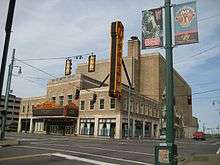 | |
| Address |
203 South Main Street Memphis, Tennessee, USA United States |
|---|---|
| Operator | Orpheum Theatre Group |
| Type | Performing arts center |
| Capacity | 2,308 |
| Construction | |
| Opened | 1928 |
| Reopened | 1984 |
| Website | |
|
Orpheum Theatre | |
| Location | 203 South Main Street |
| Coordinates | 35°8′24″N 90°3′19″W / 35.14000°N 90.05528°WCoordinates: 35°8′24″N 90°3′19″W / 35.14000°N 90.05528°W |
| Architect | C.W. Rapp and George L. Rapp |
| Architectural style | Renaissance |
| NRHP Reference # | 77001289 |
| Added to NRHP | August 15, 1977 |
The Orpheum Theatre, a 2,308-seat venue listed on the National Register of Historic Places, is located in downtown Memphis, Tennessee, on the southwest corner of the intersection of South Main and Beale streets. The Orpheum, along with the Halloran Centre for Performing Arts & Education, compose the Orpheum Theatre Group, a nonprofit corporation that relies on philanthropic support in order to sustain its education programs, quality programming, community vitality, and preservation.[1]
Entertainment
Originally built as a vaudeville house in 1928 to replace the fire-ravished Grand Opera House, which had been located on the same site, the Orpheum has been the Mid-South home of touring Broadway productions since 1977. In addition to the Broadway Series, the Orpheum Theatre Group’s two venues also host performances by Ballet Memphis, various concerts, comedians, a summer movie series, a family series of educational programs, and local cultural and community events such as Memphis in May, International Blues Challenge, and special Elvis Week events. These performances, along with the theater’s numerous educational offerings, are an integral component of the continued revitalization of downtown Memphis.
Preservation
Since it first opened in 1928, the Orpheum has dazzled patrons with its artisan millwork, gilding, original fixtures, a Mighty Wurlitzer organ, and architectural beauty. Saved by the Memphis Development Foundation (MDF) in 1977,[2] the Orpheum was one of the first buildings in Memphis placed on the National Register of Historic Places.[3] Under the leadership of the MDF, in the last 35 years the Orpheum has undergone more than $15 million in renovation and improvements that have made it a world-class performing arts facility while preserving the historical and architectural integrity of the vaudeville palace.
Venues
The Orpheum Theatre
The Orpheum Theatre, located at 203 S. Main St., opened its doors on November 19, 1928. Designed by architects C.W. and George Rapp of Chicago, the Orpheum seats just over 2,300 people and features glittering gold and silver leaf, marble, lush carpets, and antique crystal chandeliers. The theater boasts a Wurlitzer organ.[2][4]
Halloran Centre for Performing Arts & Education
The Halloran Centre for Performing Arts & Education, located next door to the Orpheum Theatre at 225 S. Main St., is the new home for the Orpheum’s community and education programs. It opened on September 23, 2015. Totaling over 39,000 square feet, the Halloran Centre provides space for classes and workshops, a large multi-use rehearsal hall, a stage, and a 361-seat theater. [1]
The Grand Opera House
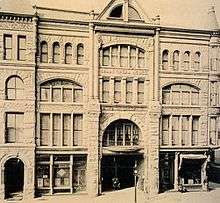
In 1890 the Grand Opera House was built on the corner of Main and Beale streets. The Grand was billed as the most classy theater outside New York City. Vaudeville was the main source of entertainment at the time, featuring singers, musicians, and magicians. The Grand became part of the Orpheum Circuit in 1907, and the theater became known as the Orpheum.
Vaudeville at the Orpheum was successful for almost two decades. Then in 1923, after a show that featured singer Blossom Seeley, a fire started and the theater burned to the ground.[5]
The Rebuild
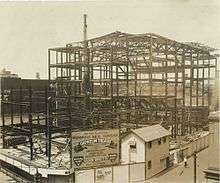
In 1928, at a cost of $1.6 million, a new Orpheum was built on the original site of the Grand, but it was a different theater. The new Orpheum was twice as large as her predecessor and opulently decorated. Lavish tasseled brocade draperies, enormous crystal chandeliers, gilded moldings, and the Mighty Wurlitzer pipe organ were just a few of its new amenities.[2]
As vaudeville’s popularity waned, the Orpheum was purchased by Michael A. Lightman’s movie theater chain in 1940, which changed the name of theater to the Malco and presented first-run movies.[6] In 1976, Lightman decided to sell the building, as intimate multiplex theaters were proving more lucrative than large single-screen venues.[2] There was talk of demolishing the old theater. However, in 1977 the Memphis Development Foundation bought the theater, restored its former name of Orpheum, and began bringing Broadway productions and concerts back to the theater.[2][7] In 1980, Pat Halloran was hired as the President and CEO of the Foundation, a position he held for the next 35 years.[8]
Restoration
Fifty-four years had taken a toll on the “South’s Finest Theatre”. The Orpheum was closed on Christmas in 1982 to begin a $5 million renovation to restore its 1928 opulence. Beyond the cleaning, decorative, and lighting changes of this once-beautiful building, significant improvements included heating, ventilation, and air-conditioning system renovations; restroom enhancements; and dressing room reconfigurations and redecorations. Other changes involved the construction of two functional loading docks, an expanded orchestra pit, and a hydraulic pit lift that added extra space to the front stage area when an orchestra wasn’t required.[9]
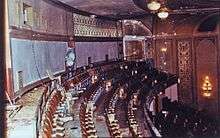
Restoration crews also cleaned the exterior of the building, repairing and repainting the Orpheum upright sign and the famous theater marquee. To meet audiences’ growing needs, a parlor with restrooms, a large concessions area, and a box office were built on the south side of the grand lobby. Later, a “green room” — now the Broadway Club — was formed in the northeast corner of the lobby, which had previously been a men’s clothing store called Bert’s. In the end, the Orpheum had a seating capacity of 2,491, including 28 new private suites.
A reopening celebration was held in January 1984.[10][11]
Renovation
In 1996, the Orpheum Theatre tackled its biggest renovation ever, at about $8 million, to expand the stage and backstage areas. New productions like The Phantom of the Opera, Miss Saigon, Beauty and the Beast, and Sunset Boulevard were the talk of Broadway, but needed more space than the Grand Old Lady had. Improvements to accommodate blossoming production scales began in spring of 1996 and continued off and on through the fall of 1997.
When the curtain opened on The Phantom of the Opera in the 1997-98 Orpheum Broadway Season, the extended stage was 50 feet deep with a once-again enlarged orchestra pit. The renovation also created 13 new dressing rooms and a special warm-up area for the ballet company. Four loading bays were constructed, doubling the previous capacity. An enormous amount of space for storage and offices was added. The walls throughout the theater were repainted and gold-leafed, and new technical equipment was installed. The theater had gotten a complete face-lift.[6][12]
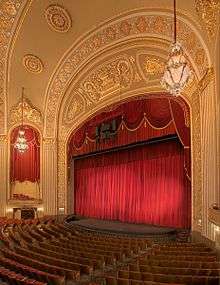
Thanks to these improvements, the Orpheum has presented numerous large-scale Broadway productions, including Disney’s Lion King, Wicked, CATS, and Les Miserables, while continuing to offer performances from great entertainers like Bob Dylan, Jerry Seinfeld, Mary J. Blige, Sarah McLachlan, John Mellencamp, Harry Connick, Jr., Tyler Perry, Tony Bennett, and many more.[1]
Continued Growth
As the Orpheum improved its on-stage offerings, efforts to advance arts education in the Mid-South were becoming just as successful. By 2012, almost 50,000 students, teachers, and families were participating in education and community outreach programs.[1]
A capital campaign was launched and The Crump Firm was hired to design a new building adjacent to the Orpheum to house these growing programs. After raising almost $15 million to build the Centre, the Board of Directors voted to name it after the Memphis Development Foundation’s retiring president, Pat Halloran.[13]
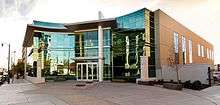
In September 2015, members of the community were invited to explore the new Halloran Centre for the Performing Arts & Education. With its 361-seat theater, the Halloran Centre also hosts concerts, dance, and other community events throughout the year, including Indie Memphis Film Festival, Collage dance Collective, and more. The Halloran Centre serves as a gathering and business space for other nonprofits and corporations, as well as a wedding, reception, and cocktail party venue.
Meanwhile at the Orpheum, ongoing improvements were completed, including eliminating two rows of seats in the center orchestra section to allow for additional legroom, which brought the seating capacity to the current 2,308.[1]
Orpheum Theatre Group
Upon Halloran’s retirement at the end of 2015, Brett Batterson was hired as the new President and CEO.[14] With this transition in leadership, the Memphis Development Foundation undertook a self-evaluation process, reimagining its vision, mission statement, and name. In May 2016, the organization adopted its new identity and an updated logo and brand design to become the Orpheum Theatre Group, a nonprofit corporation dedicated to the previously stated mission statement.[1]
Paranormal Occurrences
One of the Orpheum’s most famous patrons is Mary, the ghost of a 12-year-old[15] Stories vary about how Mary’s spirit came to stay at the Orpheum, but most suggest she was injured in an accident. Some scenarios include a 1921 car accident, while others say she was injured by a trolley in 1928 and carried inside, where she died.[16]
For more than 50 years, a variety of strange and unexplained incidents at the Orpheum have convinced many of the people who have been associated with the theater that the place is haunted. Mary has consistently been described by witnesses to have braided brown hair and a white dress and is a little shy.[17]
Performers have offered the most frequent descriptions of the ghost. Stories abound about flickering lights, tools emptied into commodes, doors swinging open and shutting loudly – events that even spooked Yul Brynner while rehearsing for The King & I in 1982.[16] Countless times over the past 50 years, performers have noticed a little girl in what looks like a school uniform sitting in a side box on the mezzanine. Her blank stare and ethereal appearance have upset some of those who have seen her. Yet, Mary is never known to have disrupted a performance.[16][18]
A group of paranormal researchers from the University of Memphis, then known as Memphis State University, found that a ghost does, as legend suggested, live in the Orpheum and call herself Mary. Using séances and a Ouija board, the researchers found a contrasting story to the more common legend of the streetcar incident. They believe the little girl died in 1921 in some sort of falling accident in the downtown area, which had nothing to do with the theater.[16][17] According to the University of Memphis group, Mary “wandered into the Orpheum after her death, and she liked it. So she stayed.”[18]
Memphis historian Vincent Astor, along with other researchers and patrons, have claimed to be aware of as many as six other spirits inhabiting the Orpheum, including a male, known to some as David, who is waiting to escort Mary to the other side. Since she refuses to leave the beautiful old theater, however, he cannot leave either and is therefore spending eternity in the theater with her.[19]
Others include an “unhappy” spirit, referred to as Eleanor, in the foyer of the balcony. Astor described a cold feeling in the balcony – like putting “your hand in a tub full of raw liver” – but does not believe that Eleanor is a malevolent spirit.[19]
References
- 1 2 3 4 5 6 Memphis, The Official Website of The Orpheum Theatre. "The Official Website | The Official Website of The Orpheum Theatre Memphis". www.orpheum-memphis.com. Retrieved 2016-07-12.
- 1 2 3 4 5 Williams, Noni (June 23, 1977). "Memphis Daily News". New Memphis Landmark: The 50-Year-Old Orpheum.
- ↑ "National Register of Historic Places" (PDF).
- ↑ Halloran, Pat (2015). Phases and Stages of a Grand Dame: The Story of the Orpheum. Image Publishing.
- ↑ "The Commercial Appeal". ‘Music Hall of the South’ was never just a theatre. January 16, 1965.
- 1 2 "Orpheum Theatre in Memphis, TN - Cinema Treasures". cinematreasures.org. Retrieved 2016-07-12.
- ↑ "Hopkins Grand Opera, Orpheum Theatre, Malco Theatre, Memphis". www.historic-memphis.com. Retrieved 2016-07-12.
- ↑ "Exiting the Stage: Pat Halloran embarks on his final year at the Orpheum helm". Retrieved 2016-07-12.
- ↑ Branston, John (March 18, 1983). "The Commercial Appeal". Restoration keeps pace at Orpheum.
- ↑ Fulbright, Alice (January 7, 1984). "The Commercial Appeal". Dance will follow on heels of Champagne & Gershwin.
- ↑ "Mid-South Business Journal". Resurgence in downtown; Curtain going up Saturday at new Orpheum. January 2–6, 1984.
- ↑ Smith, Whitney (November 7, 1997). "The Commercial Appeal". Phantom to rise on stage as dust settles.
- ↑ "New Orpheum center to be named after longtime president Pat Halloran". Retrieved 2016-07-12.
- ↑ "Chicago's Batterson selected to take reins of Orpheum". Retrieved 2016-07-12.
- ↑ "Four Halloween ghost stories to get you into the spirit". Retrieved 2016-07-12.
- 1 2 3 4 Brown, Alan (2002). Haunted Places in the American South. University Press of Mississippi.
- 1 2 Ewing, James (1986). It Happened in Tennessee. Rutledge Hill Press.
- 1 2 "Memphis Hauntings, Orpheum Theatre - HauntedHouses.com". www.hauntedhouses.com. Retrieved 2016-07-12.
- 1 2 Orpheum Memphis (2012-10-29), Orpheum Ghost Stories with Vincent Astor, retrieved 2016-07-12
| Wikimedia Commons has media related to Orpheum Theater (Memphis, Tennessee). |
External links
- Dark Destinations - Orpheum Theatre - info on haunted locations






